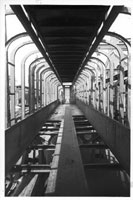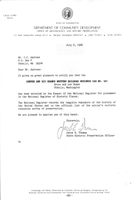| 1862: Authorizing the Transcontinental Railroad | |||||||||||
|
In 1862, President Abraham Lincoln signed The Pacific Railroad Act, authorizing the Union Pacific and the Central Pacific railroads to build what was to be the nation's first transcontinental railroad and telegraph line. In 1864 a private railroad car was built for the president but Lincoln was unable to use it while he lived and the ornate style of the car was not to his liking. This car was then to become his funeral car and a replica of it is another of the Lincoln items on display at the Union Pacific Railroad Museum in Council Bluffs, Iowa. Many of the original furnishing from that car are numbered in the Lincoln collection - a walnut desk, bookcase, a reclining chair, a portion of the silver service, a mirror, four oil paintings and two davenports, one extra long for the president and capable of being converted into a bed. |
|
|
||||||||
1865: George Pullman |
|||||||||||
|
Mr. Pullman's third attempt at a rail passenger car was completed. His patented and revolutionary concept in traveling became reality in The Pioneer. It was a passenger car never before imagined, being two and a half feed higher and a foot wider than any other car. It was designed for passenger comfort with more elegance in every aspect than any existing carriage. However, being oversized, it was prohibited from movement as the tracks did not provide sufficient clearance for its safe passage. Mr. Pullman, a long time friend of the Lincoln family, offered the widowed Mary Todd Lincoln and her son Robert Todd the use of the railroad passenger car that was fifty years ahead of it's time. To accommodate this wider car for the funeral train, all clearances between Washington D.C. and Springfield Illinois were hastily modified for Pullman's larger car. This single action changed from what could have been Pullman's "white elephant" into what rapidly became the most sought after series of cars of the era. Within a few years, all the nation's railroads were adapting to the ten-foot wide and fourteen-foot high railroad car Pullman built in 1865, and which remains the standard in the United States even today. | For a more information on the technology behind the Pullman Company, click here. | |||||||||
1910: A year of change for the Pullman Company |
|||||||||||
|
President Lincoln and Mary Todd Lincoln had four sons, with only Robert Todd living to maturity. Robert Todd, a lawyer, was counsel to corporate interests including the Pullman Company. After Mr. Pullman's death in 1897, The Pullman Company operated for two years before electing the long time friend of Pullman to the position of company president. Robert Todd became the president of the Pullman Company in 1897 and resigned in 1911, for reasons of health, but remained as chairman of the board. During this time, the Pullman Company was in technological turmoil. They suddenly changed from the 60 foot varnished wood railroad cars to the eighty foot, riveted-steel design. The new technology of the time was electric lighting, so the new cars required the addition of electrical wiring, switches, switchboards, generators, and batteries. Wood and steel trucks were replaced with massive structural steel castings. It was September of this year that Coach 895 was manufactured for the Western Pacific Railroad at an original cost from the Pullman company of $13,624.50. |
|
|
||||||||
 |
|||||||||||
| (Above) 1910 Photograph of Coach 895 (later to become the D&RG 101 and finally the Abraham Lincoln). | Building a Pullman Steel Heavyweight car in 1910 at the Pullman Car Company Factory | ||||||||||
1924-1929: Rebuilt as the D&RG 101 |
|||||||||||
On January 11, 1924, Coach 895 became D&RGW 926. At that time, its book value was given at 8,783.90. In 1929, the railroad car was and rebuilt in Burnam to a self-contained business car for the President of the Denver & Rio Grande Western Railroad. Numbered the 101, it was complete with staterooms, office, bathrooms, observation room, kitchen, dining room, and porter's compartment. At this time, the 101 was refitted with six-wheel trucks (estimated book value of $580.65). The (used) 1910 trucks were from one of the three buffet-library cars originally built for the Western Pacific, which were renumbered 981, 982, and 984 in 1915-16. These buffet-library cars were moved to a lower service D&RGW baggage cars 741, 742, and 744, and their six-wheel trucks replaced with two-axle trucks in 1929. Four of these trucks are the ones that found their way to the D&RG Car 101 and Car 102. The rebuild cost $33,294.22 in December of 1929 is when it received its present design and floor plan. Car 101 was the pride and status symbol of the powerful and elite in the business world, but within two weeks of its unveiling, the stock market crash of 1929 brought reality back into perspective. The 101 was built and initially assigned to the president of the D&RGW. THE ABRAHAM LINCOLN is a unique example of rail cars at the turn of the century. It has survived almost a hundred years as a rare example of” state of the art” 1910 railroad technology. The interior is distinguished by its hand crafted satin walnut lightly accented with bronze hardware and richly tailored fabrics. At some later date, the 101 was assigned to John (Jack) Ayer, Jr., who was the chief engineer from 1951-1962, and later became the general manager. The 101 had a sister car, the 102, which was assigned to Leonard Hale, Superintendent of transportation, who was assisted by Mr. Jackson C. Thode, who graciously provided much of the history on the 101. Mr. Thode is the author of Volume I and II of George L. Beam and the Denver Rio Grande which is a Photographic History of the D&RG Railroad.
|
|
|
|||||||||
| Mortgage plate on sill of the Abraham Lincoln | |||||||||||
|
|
||||||||||
|
|
||||||||||
|
|||||||||||
| 1983: Renamed from the D&RG 101 to the Abraham Lincoln | |||||||||||
The Pullman car was found in 1981 (at that time named the Prospector) and purchased from Thomas Pearson and Craig . Rasmussen on November 13th, of 1983 by Mr. Curtis Andrews and transported from Los Angeles to Peter Robbins' Rail Passenger Services shop in Tucson, Arizona for eight months for mechanical rebuilding of the car's undercarriage to make it rail-worthy. The mechanical restoration included purchase and installation of newer (1945) trucks (the part of a railroad car which has the axles) to replace the three-axle 1910 trucks which had been installed in the 1929 upgrade. (Read more about our restoration effort on our restoration page). These newer style integral cast trucks were once used under a US Army hospital car. The car also received a new brake system for its six axles and a 45 page engineering analysis. After rebuilding in Arizona, the car traveled to Spokane, Washington via Amtrack and the final leg from Spokane to Bruce, Washington, a railroad siding and industrial site just east of Othello. The tradition of numbering this class of railroad cars had changed to giving the cars names, so this car was renamed the Abraham Lincoln. The Abraham Lincoln's antiquated elegance is not only rare, but it is also the oldest operational car in America. This attests to the knowledge of the early steel engineers, the attitude to make something last, and the desire for quality. The extensive restoration of the Abraham Lincoln has returned it to the simple elegance of the 1920s. Mechanical and interior details of the car may be found at: Details |
|||||||||||
| Visit the restoration page for dozens of photographs showing the restoration process | |||||||||||
|
|||||||||||
| 1988: The 101 is added to the United States National Historic Register | |||||||||||
On July 8, 1988, Curtis Andrews received notification from Jacob Thomas, the Washington State Historic Preservation Officer, that the Denver and Rio Grande Western Railroad Business Car No. 101 has been selected by the Keeper of the National Register for placement in the National Register of Historic Places. The National Register records the tangible reminders of the history of the United States and is the official list of the nation's cultural resources worthy of preservation. |
 |
||||||||||
|
|||||||||||
| 2005: The Abraham Lincoln celebrates its 95th Anniversary | |||||||||||
While the Lincoln has not seen as much track as we had hoped, the restoration which has taken place over the last twenty years has fully restored the interior and exterior of The Abraham Lincoln to the original beauty of her 1929 rebuild. Our primary goal now is to catch back up with the changing Amtrak regulations and add head end power (HEP) which is now required for Amtrak re certification. For more information on head end power and why it has become so important to us, see our HEP page. 2005 also is the year which we obtained our domain and web site. If you have an interest in how this came about, click here for our web site history |
|||||||||||



